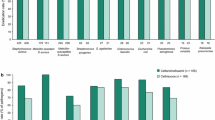Summary
Cefotiam hexetil is a pro-drug of cefotiam available for oral administration. To evaluate cefotiam concentrations at the active site in skin and soft-tissue infections, drug levels in skin suction blister fluid (SBF), cantharides blister fluid (CBF) and serum were determined. Six healthy subjects received oral cefotiam 400 mg as cefotiam hexetil. On an other day 200 mg was injected intravenously.
Following the oral dose, the bioavailability of cefotiam was 45.5%, and the maximum concentration in serum of 2.6 mg·1-1was obtained at 2.1 h. Peak concentrations in both types of blister fluid (0.9 mg. 1-1) were significantly lower than after the iv dose (SBF 1.4 mg.1-1, CBF 1.5mg.1-1), and the peak levels occurred later (3.3 versus 1.5 h in CBF). Despite the delay, the extent of penetration was about 100% following either mode of administration (SBE iv dose 112%, oral dose 117%). The cefotiam level in skin blister fluids declined significantly more slowly than the serum level. Following the oral dose, the mean terminal half life was serum 0.8 h, SBF 2.6 h and CBF 4.6 h.
Cefotiam concentrations in the blister fluids were close to the MIC90 ofStaphylococcus aureus, S. epidermis andH. influenzae and exceeded the MIC90 of Streptococci,E. coli andProteus mirabilis.
Thus, the oral administration of cefotiam 400 mg t. i. d. should be curative in the majority of bacterial infections of the skin and soft-tissues.
Similar content being viewed by others
References
Grimm H (1981) Bakteriologische In-vitro-Untersuchungenmit einem neuen Cephalosporin: Cefotiam. Arzneimittelforsch 31: 1867–1869
Bodey GP, Fainstein V, Hinkle AM (1981) Comparative in vitro study of new cephalosporins. Antimicrob Agents Chemother 20: 226–230
Finch R (1988) Skin and soft-tissue infections. Lancet I:164–167
Johnson JD (1986) The cephalosporins in dermatologic practice. Int J Dermato1 25:42–430
Nishimura T, YoshimuraY, Miyake A, Yamaoka M, Takano- hashi K, Hamaguchi N, Hirai S, Yashiki T, Numata M (1987) Orally active 1-(cyclohexyloxycarbonyloxy)alkyl ester prodrugs of cefotiam. J Antibiot (Tokyo) 40:81–90
Parish LC, Cocchetto DM, Werner K, Jungkind DL, Witkowski J (1987) Cefuroxime axetil in the treatment of cutaneous in- fections. Int J Dermato1 26:389–393
Gudgeon AC, Vandenburg MJ, Wight LJ, Griffiths GK, Kelsey M (1987) Is oral cefuroxime axetil suitable for the treatment of unidentified bacterial infection of skin and soft tissue? Br J Clin Pract 41: 954–956
Harding SM, Williams PEO, Ayrton J (1984) Pharmacology of cefuroxime as its 1-acetoxyethyl ester in volunteers. Antimicrob Agents Chemother 25:78–82
Finnerty EF, Folan DW jr (1979) Cefaclor in the management of common bacterial skin diseases. Cutis 24:304–306
Dillon HC jr, Gray BM, Ware JC (1979) Clinical and laboratory studies with cefaclor: efficacy in skin and soft tissue infections. Postgrad Med J 55 [Suppl 4]: 77–81
Kiistala U (1968) Suction blister device for separation of viable epidermis from dermis. J Invest Dermato1 50:129–137
Wise R, Gillett AR, Cadge B, Durham SR, Baker S (1980) The influence of protein binding upon tissue fluid levels of six 13-1ac- tam antibiotics. J Infect Dis 142:77–82
Schafer-Korting M, Korting HC, Mutschler E (1985) Human plasma and skin blister fluid levels of griseofulvin following a single oral dose. Eur J Clin Pharmaco1 29:109–113
Schäfer-Korting M, Korting HC, MassL, Klesel N, Grigoleit HG, Mutschler E (1986) Cefodizime penetration into skin suc- tion blister fluid following a single intravenous dose. Eur J Clin Pharmaco1 30:295–298
McNamara PJ, Gibaldi M, Stoeckel K (1983) Fraction unbound in interstitial fluid. J Pharm Sci 72:834–836
Adam D (1982) Pharmakokinetik yon Cefotiam. In: Lode H, Adam D: Cefotiam - Standortbestimmung eines neuen Antibio- tikums. Excerpta Medica, Amsterdam, pp 63–72
Korting HC (1984) Plasma and skin blister fluid levels of cefo- tiam and cefmenoxime after single intramuscular application of 1 g in gonorrhea. Chemother 30:277–282
Schfifer-Korting M, Korting HC (1989) Skin blisters and skin windows: an access to total and free drug concentrations in the skin. In: Maibach HI, Lowe NJ (eds) Models in Dermatology, Vol 4. Karger, Basle, pp 45–62
Korting HC, Neubert U (1985) Treatment of gonorrhoea with cefotiam: activity in vitro and clinical results of a 1-gram-single- dose regimen. Dermatologica 171:264–268
Brisson AM, BryskierA, Millerioux L, Fourtillan JB (1984) Pharmacokinetics of cefotiam administered intravenously and intramuscularly to healthy adults. Antimicrob Agents Che- mother 26:513–518
Murphy CF, Webber JA (1972) Alteration of the dihydrothi- azine ring moiety. In: Flynn EH (ed) Cephalosporins and peni- cillins. Chemistry and biology. Academic Press, New York pp 134–182
Finn A, Straughn A, Meyer M, Chubb J (1987) Effect of dose and food on the bioavailability of cefuroxime axetil. Biopharm Drug Dispos 8:519–526
Glynne A, Goulbourn RA, Ryden R (1978) A human pharma- cology study of cefaclor. J Antimicrob Chemother 4:343–348
Wise W, Andrews JM, Bedford KA (1981) Cefoperazone and cefotiam two new cephalosporins: an in vitro comparison. Anti- microb Agents Chemother 7:343–352
Braveny I, Machka K (1979) Activity of cefotiam (CGP 14 211/E) against Haemophilus influenzae, Neisseria gonorrhoeae, and Neisseria meningitidis, including β-1actamase-producing iso- lates, in vitro. Antimicrob Agents Chemother 1:225–227
Fock RRE, Thormählen B, Laufs R (1983) In vitro activity of 13 cephalosporiu antibiotics against the most frequent species iso- lated from blood cultures. Drugs Exp Clin Res 9:639–546
Author information
Authors and Affiliations
Rights and permissions
About this article
Cite this article
Korting, H.C., Schäfer-Korting, M., Kees, E. et al. Skin tissue fluid levels of cefotiam in healthy man following oral cefotiam hexetil . Eur J Clin Pharmacol 39, 33–36 (1990). https://doi.org/10.1007/BF02657053
Received:
Revised:
Issue Date:
DOI: https://doi.org/10.1007/BF02657053




